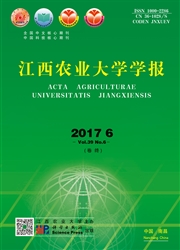

 中文摘要:
中文摘要:
利用遮阳网模拟弱光条件,调查12份辣椒种质苗期株高、单位叶片株高、下胚轴长、叶长、叶宽、叶厚、茎粗、单株叶数、植株鲜质量、叶鲜质量、茎鲜质量和根鲜质量等形态性状,以耐弱光系数作为衡量耐弱光性的指标,应用因子分析、隶属函数和聚类分析,对辣椒耐弱光性进行综合评价。结果表明:12个形态性状的耐弱光系数在参试种质间差异较大,利用因子分析将其集约于5个主因子上,即株型因子、鲜质量因子、叶数因子、叶厚因子和下胚轴长因子,5个主因子累计贡献率达97.30%。根据综合评价值D,将12份供试种质分为4类,即耐弱光材料H101A、V06C0298、H107;较耐弱光材料V06C1825、H101、GX;弱光中度敏感材料SEC、H102、V06C1032、H108、H103以及弱光敏感材料H107B。本研究应用多元统计方法成功地对12份辣椒材料进行了耐弱光性鉴定,可为辣椒耐弱光性育种提供理论参考。
 英文摘要:
英文摘要:
With block light net simulating the low light condition, twelve pepper accessions were used to evaluate their low light tolerance by means of factor analysis, subordinate function and cluster analysis based on the low light resistant index correlation matrix of 12 morphological characters at the seedling stage. The 12 traits included plant height, plant height per leaf, hypocotyl length, leaf length, leaf width, leaf thickness, stem diameter, leaf number per plant, fresh plant weight, fresh leaf weight, fresh stem weight and fresh root weight. The result indicated that the low light resistant index of the 12 morphological traits in different acces- sions showed great difference, and those indexes could be characterized into five main factors by factor analy- sis, namely plant type factor, fresh weight factor, leaf number factor, leaf thickness factor and hypocotyl length factor, and the accumulative contribution rate hit to 97.30%. Cluster analysis based on D value showed that the twelve accessions could be classified into four categories: the best low light tolerant accessions inclu- ding H10!A, V06C0298 and H107, and the stronger low light tolerant materials including V06C1825, H101 and GX, the moderately sensitive materials including SEC, H102, V06C1032, H108 and H103, whereas the low light sensitive materials was H107B. The study applied multiple statistics analysis to access the low light tolerance of the 12 pepper accessions successfully, and could offer theory reference for low light tolerance breeding in pepper.
 同期刊论文项目
同期刊论文项目
 同项目期刊论文
同项目期刊论文
 期刊信息
期刊信息
